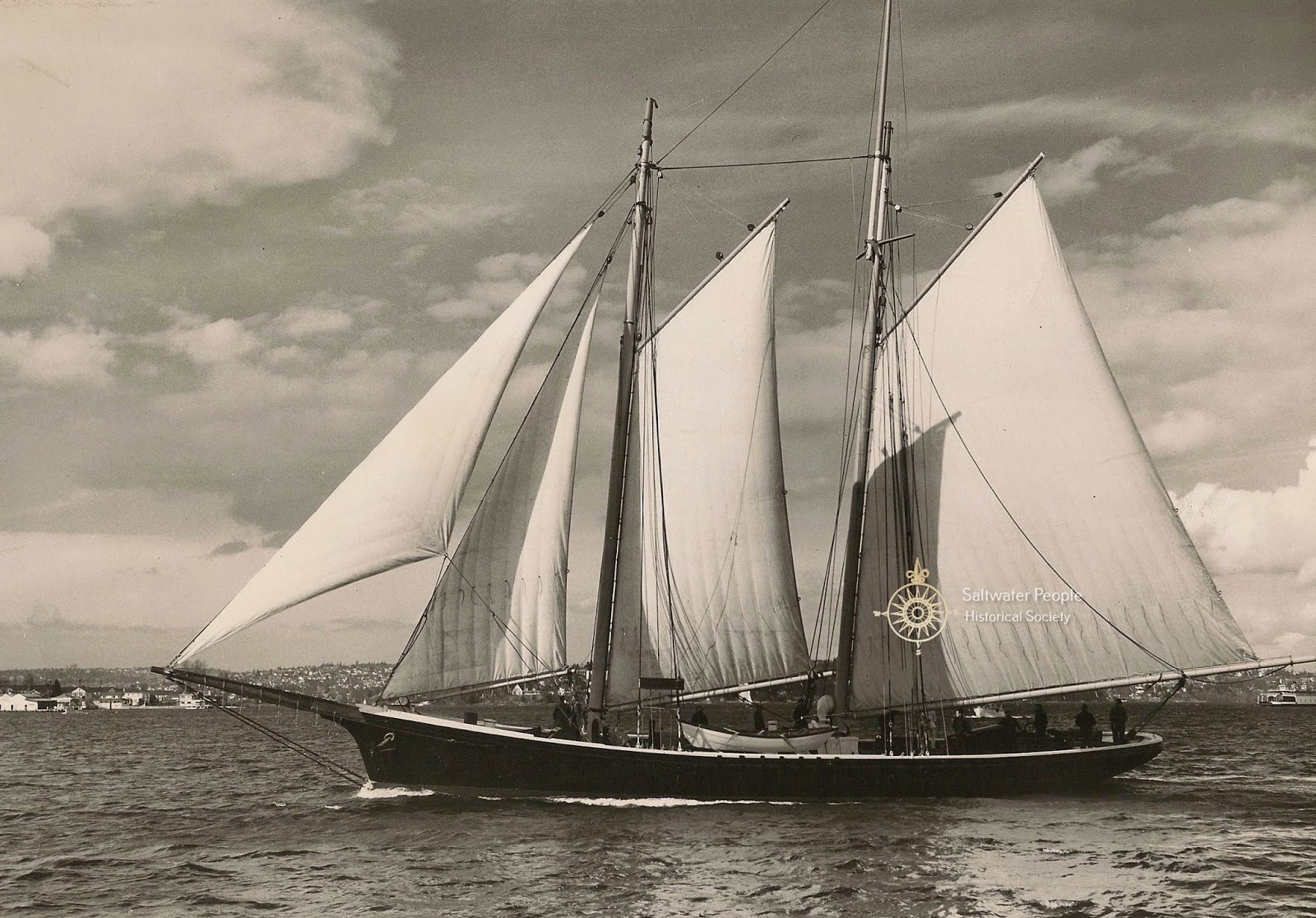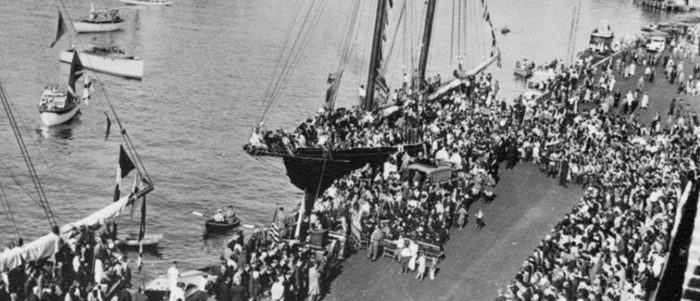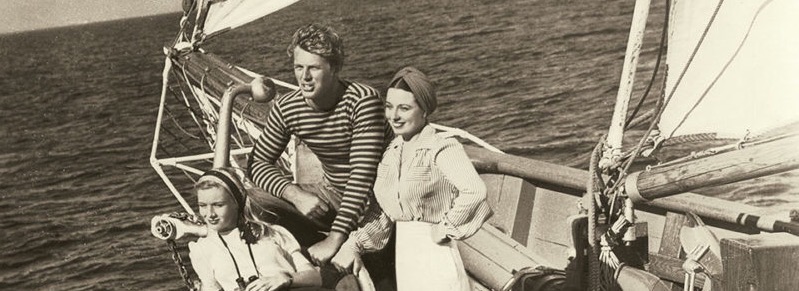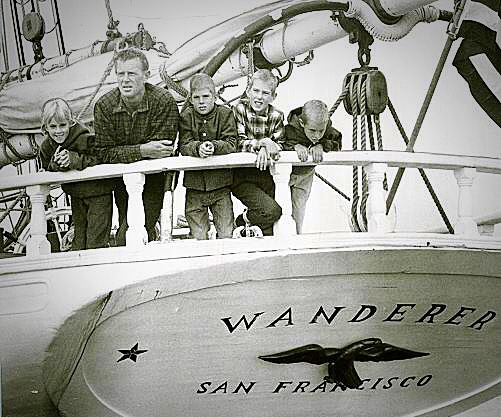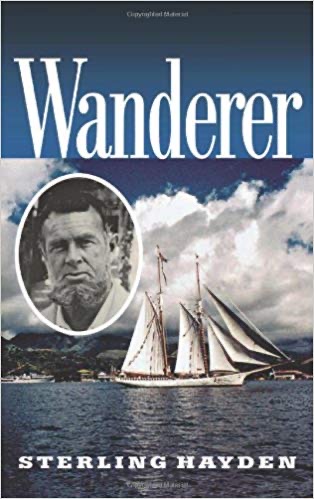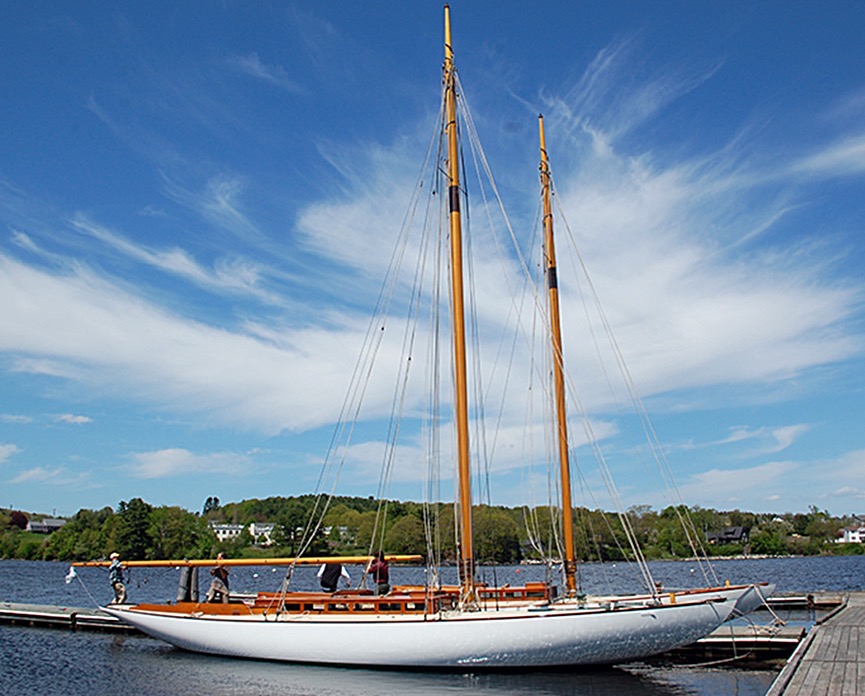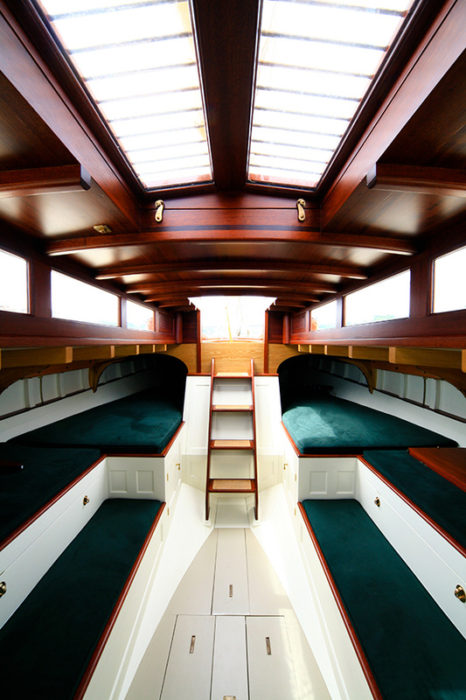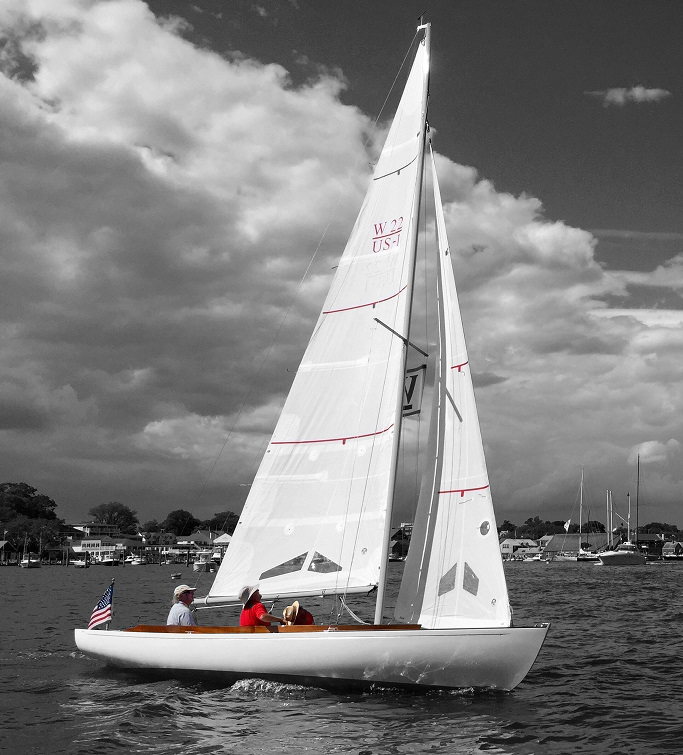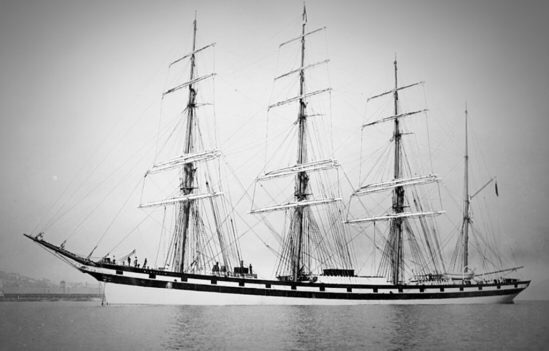
Vessel Type: Four-masted steel barque
LOA: 308’9″ / 94.10m – LOD: 359’0″ / 109.00m – Beam: 45’11″ / 14.00m – Draft: 25’7” / 7.80m – Displacement: 2,903.29 gross tons / 2,800.59 net tonnage – Sail Area: – Original Name: Ships name suggested by the son of Wanderer owner W.H. Potter. Name given by Mrs. W.H. Potter, as the vessel stood on the ways before launching. – Original Owner: Wanderer S. Co., W.H. Potter & Sons, Liverpool – Year Launched: August 20th, 1891 – Engine: – Crew: Twenty able-bodied seamen, in total thirty-seven men – Built by: W.H. Potter & Sons, Liverpool, Yard No. 150 – Designed by: P.S.P. Morter – Hull Material: Metal hull on metal frames. – Homeport: – Status: Lost at 2a.m. on April 14th. 1907
In Literature
1891 THE WANDERER AT KINGSTOWN
By Cormac F. Lowth
First published in the Dun Laoghaire Borough Historical Soc. Journal

The WANDERER was a magnificent steel four-masted sailing barque, built and owned by W.H.Potter and Co. of Queen’s Dock Liverpool and launched on Thursday the August 20th. 1891. Her building was supervised personally by the owner, Mr. Potter, and he apparently intended to make her the strongest and most beautiful ship afloat. According to Masefield, many sailors were of the opinion that he had succeeded in this. She had many unusual features including having all of the crew’s accommodation and the steering wheel located centrally in the ship. Her notable sheer forward was complimented by a beautifully carved wooden figurehead of a draped female form with a hand uplifted over her brow. This had been modelled by Mrs. Potter, the wife of the owner, a lady with “A face of singular sweetness”.
The finished weight of the WANDERER was 1780 tons and she could carry about 4,500 tons of cargo. Her dimensions were, length 309 feet, beam 46 feet, depth 25.8 feet. Her glistening yellow pine decks contrasted nicely with her black and white top-sides which had painted black imitation gun-ports in the fashion of many large British sailing ships of the time.
The ship was launched by Mrs. Potter and on the September 14th. she was towed to the west float in Birkenhead to load steam coal for San Francisco. Her crew of thirty six men and boys were signed on by Captain George Currie, a Nova Scotian who had commanded another of Potter’s ships, the WAYFARER, for the past five years.
Throughout the previous week howling gales had lashed the British Isles relentlessly and it was said that Mr. Potter had advised Captain Currie to delay setting out on the ship’s maiden voyage, however, Captain Currie felt, despite the severe westerly winds which had closed down the Mersey ferries and caused many shipping casualties around the coast, that October 17th would be a good day to start as it was the anniversary of his taking command of the WAYFARER. The decision to sail, which he had hoped to be auspicious, would however, prove to be a fatal one for Captain Currie.
The Poet Laureate John Masefield was essentially a sea poet; the sea was what he knew and wrote about best. Few will not be familiar with what is perhaps his best known work, SEA FEVER, with the immortal lines:
I must go down to the sea again, to the lonely sea and the sky,
And all I ask is a tall ship and a star to steer her by.
Coming perhaps a close second might be his poem CARGOES which mentions,
“Dirty British coaster with a salt caked smokestack,
Butting through the Channel in the mad March days”.
Masefield had sailed on square-riggers and he wrote about shipboard life and captured the atmosphere of the big cargo carrying Cape-Horners in epic Poems such as DAUBER and THE YARN OF THE LOCH ACHRAY in an evocative way that has never been surpassed. He made a special case for the barque WANDERER by devoting an entire book to the subject in which roughly half of the story is recounted in prose, the rest in poetry.
Masefield begins his poem of the WANDERER as she left the Mersey towed by the tug WRESTLER. Off Holyhead the towrope parted and with great difficulty the vessel was got under sail but as they sailed down the Irish Sea the full fury of the tempest struck the ship and blew out most of the sails. As she wallowed out of control much of the upper rigging and spars collapsed and crashed to the deck. Some of the wreckage struck Captain Currie on the head and he was brought below, still alive, and laid on the cabin table where he died soon after. The ship was now just off the Codling Bank and after blue lights were lit and rockets were fired denoting distress, the ship was taken in tow by the small coasting steamer MERANNIO and towed to Kingstown. Masefield writes:
When morning from wind-harried heaven showed wind-shattered sea,
The steamer drew nearer attempting to take her in tow,
She hove up to windward and fired her rockets with lines,
But time after time ere the hawsers were fast to the tow,
The WANDERERS sheerline bowed into the run of the sea,
And lipped up the living green water, and rising, deep filled,
Streamed with bright water and plunged, snapping hawsers like pack thread.
They laboured all morning while slowly the tempest blew by,
At last when the hawser was passed, the MERANNIO moved
Westwards, to tow her to Kingstown, and heavens face altered
And sunlight came squally with showers of violent rain
And blue sky grew brighter and seagulls adventured to sea.
At moonrise the tug FLYING SPEAR helped the towing up
By moonlight next morning they moored her and made her secure.

The WANDERER was moored close to the East Pier in Kingstown for three and a half days and during her time there she excited a great deal of interest among the local population, many of whom walked down the East pier to view the ship. The coroner did not deem it necessary to hold an inquest on the death of Captain Currie and the body was taken ashore and buried in Mount Jerome Cemetery in Harold’s Cross. The funeral was attended by the ships officers and apprentices. All who had served under Captain Currie agreed that he was a fine and noble gentleman and a good seaman. The Captain’s grave was marked with a headstone and the number of the plot has been discovered by the author. Unfortunately when visited by the Author, this corner of Mount Jerome graveyard was greatly overgrown with vegetation presently and it was not possible to determine exactly where the Captain lies.
There is a fine model of the WANDERER in the Merseyside Maritime Museum and displayed alongside it are copies of some pages of the personal diary of 14 years old H. Watson who was an apprentice deck officer on the ship. He describes the events leading to the Captain’s death.
….We had then some sail spread out, this got torn to pieces on account of the spars shifting. Nothing could be done but for hands to go aloft and cut away the rigging so as to free the ship which at this time was rolling very heavily indeed. It was near midnight and the captain was on the poop firing rockits (sic) as signals of distress. While thus engaged he was struck by the skysail yard and knocked down on the deck insensible. The second mate was the first to see him and he along with the third mate and steward got him into his room. He lay insensible till four o’clock on Monday morning and then expired. By this time the wind had abated a little but the sea was still very high. At eight o’clock a.m. a steamer was sighted and we signalled to her. She made towards us and by twelve o’clock noon we got her fastened to, then began towing for Kingstown, Ireland. We got there by eight o’clock the same evening and cast anchor in the harbour.
On Friday the 23rd of October the tug WRESTLER came from Liverpool and once more took the WANDERER in tow. The Irish Sea was not yet finished with the WANDERER as she went aground by the stern on the Burford Bank while under tow. The tide was rising and she soon floated free. She presented a bedraggled sight as she entered her home port in contrast to the magnificent ship which had sailed from there only a short time before. There are several photographs in existence of the WANDERER moored in Kingstown Harbour, some showing the damage to the rigging, and some with the tug WRESTLER alongside.
Masefield had written another poem about the WANDERER before he wrote the book on the subject, which contains the following lines:
“So she is putting back again,” I said.
“How white with frost her yards are on the fore!”
One of the men about me answer made,
“That is not frost, but all her sails are tore,
“Torn into tatters, youngster, in the gale;
Her best foul-weather suit gone.” It was true,
Her masts were white with rags of tattered sail
Many as gannets when the fish are due.
Beauty in desolation was her pride,
Her crowned array a glory that had been;
She faltered tow’rds us like a swan that died,
But although ruined she was still a queen.
The subsequent story of the WANDERER is a long and eventful one. She had acquired a bad name after killing her Captain on her maiden voyage and she seemed determined to live up to it. There were fires, collisions, groundings, more partial dismastings and men fell from the rigging on many occasions but she was probably no more unlucky than any of the big steel sailing ships of the time which relied on the vagaries of the wind and sheer manpower to get them about the globe.

The end came for the WANDERER at about 2a.m. on April 14th. 1907 as she was anchored in the Altenbruch road in the River Elbe awaiting a pilot and tug to take her up to Hamburg to load coal. The riding lights of the WANDERER were obscured by the bright lights of a liner in the background and the German Twin Screw steamer GERTRUD WOERMAN, which was making about fourteen knots upriver with the flood tide, ploughed into the port bow of the anchored sailing ship. All hands took to the boats and were picked up safely by a tug. Shortly after, the WANDERER rolled over to port and sank in the River Elbe, where, after some dispersal with dynamite, she remains to this day. The following are some of Masefield’s final lines on the WANDERER:
Since nothing could save her, men blasted the wreck from the stream,
And left her dead bones in the quicksand full fathom five down,
She lies there sunken, unminded, sea creatures encrust her,
White shells, such as cover the SIREN, red frond waving weeds.
Perhaps a more fitting epitaph for the WANDERER might be the final lines of Masefield’s wonderful poem “Ships” in which he mourns the passing of the tall ships:
They mark our passage as a race of men,
Earth will not see such ships as those again.
Provenance- The Wall of Remembrance – The Owners, Crew & Notable Guest:
- Owner/Guardian: W.H. Potter, was born in Hull in the year 1827
- Master: Captain George Currie, Nova Scotia (command 1891 August 20 – October 17)
1891 August 20 – Launched at the shipyard of W.H. Potter & Sons, Liverpool, for their own account. Captain George Currie late of the same owner’s fullrigged ship Wayfarer was given command of the new ship.
1891 October 17 – Left Liverpool for San Francisco with a cargo of Westminster Brimbo Steam coal. Was partly dis-masted off Tuscar and had to be towed back to Liverpool. Captain Currie was killed by a falling skysail yard.
- Chief Mate: George Shearer, Banff, was in his thirtieth year. He had recently married and had spent his honeymoon on board the Wanderer while fitting her for sea.
- Second Mate: Thomas P. Baker, who had been born at sea, was a man of twenty-four.
- Third Mate: Walter Jones of Birmingham
- Boatswain: John Walter
- Carpenter: John Jones
- Engineer: J. McIntyre
- Steward: Maltese E. Cross
- Cook: A Burke
- Master: John Brander (command 1891 November 21 – September 22, 1896)
- Master: Captain T.S. Tupman (command 1896 November 19, 1896 – March 18, 1900)
The Fourth Voyage:
- Master: Captain T.S. Tupman
- Chief Mate: J.W. Willoughby
- Second Mate: Alexander Jones
Left Philadelphia November 19th, 1896, with 118,200 cases of oil arrived Hiogo March 31, 1897.
Left Hiogo August 15th, 1897, arrived in Tacoma September 14th, 1897
Left Tacoma November 18th, 1897 with Wheat, arrived in Dunkirk April 10th, 1898.
The Fifth Voyage:
- Master: Captain T.S. Tupman
- Chief Mate: J.W. Willoughby
- Second Mate: Alexander Jones
- Third Mate: E. Westlake
Left Liverpool June 18th, 1898, arrived in Dunkirk June 22nd.
Sailed from Dunkirk July 8th, with chalk, arrived in Philadelphia August 15th.
Left Philadelphia September 30th with oil, arrived in Bombay January 22nd, 1899 – 115 days out, then proceeded to Calcutta. Chief Mate: J.W. Willoughby left the ship in Calcutta June 9th, 1899.
Third Mate E. Westlake promoted to second mate
Left Calcutta June 26th, with 5,000 tons of linseed in bags, arrived in Dunkirk October 31st – 127 days out.
Left Dunkirk December 1st with chalk arrived in New York January 13th, 1900.
Left New York February 28th, 1900, with 118,837 cases of oil, arrived in Shanghai July 17th.
Left Shanghai August 15th, arrived in Tacoma September 24th
Left Tacoma October 13th with wheat arrived in Bristol March 18th, 1901
- Master: Captain T.S Bailey (command April 13, 1901 – May 22, 1901)
- Master: Captain Thomas Dunning (command sixth- ninth voyage June 15, 1901 – April 14, 1907) was the vessels last skipper, having had to abandon ship on that fateful April in 1907:
The Sixth Voyage:
- Master: Captain Thomas Dunning
- Chief Mate: W. Christian
- Second Mate: J. Cox
Left Bristol April 13th 1901, as the ship was towed down the River Avon, also known as the Bristol Avon (Avon welsh derivative meaning River) a woman was seen pacing the ship from shore waving to one of the few white men in crew. This man later had said he had murdered the lady’s husband for love, and that he wanted to marry her. The Captain was later confined to the chartroom, while the second mate was ill. When the ship reached New York on May 22nd Captain Bailey left command. Arriving from England Captain Thomas Dunning took command of the vessel on June 15th.
1901 July 9 – December 12 – Sailed from New York to Shanghai with 119.207 cases of oil, under command of Captain Thomas Dunning. On the passage to Woosung October 10th, 1901 7:50am C. Christiansen 25, fell overboard from the yard while reefing the fore upper topsail, and was never seen again. Bubonic plague outbreak in Shanghai from rats within grain. No grain or fever came onboard, while Moore there, but some of the crew were incapable of duty due to consumption of native liquor.
Left Shanghai, January 3rd, 1902 arrived Port Townsend February 1st.
The Seventh Voyage:
- Master: Captain Thomas Dunning
- Chief Mate: H.G. Godwin
- Second Mate: John Sinclair
Left Cardiff August 25th, 1902 and arrived in Philadelphia September 21st.
Left Philadelphia October 5th, 1902 with 120,00 cases of oil, arriving in Kobe March 8th, 1903, where chief mate Godwin left the ship.
Left Kobe April 8th, 1903 arriving in Tacoma May 9th. While in Tacoma one of the crew and a burglar from shore robbed the ship of all of her compasses and misc paints. Theft was discovered at once, the goods recovered and the men were jailed.
Just before the ship was set to depart for Queenstown, the boatswain, after being tempted ashore, deserted his post and was recovered by paying the crimps thirty-five dollars in blood money to recover him. In order to stop this process the Seamen’s Act of 1915 was passed by congress that made crimping a federal crime, and finally this put an end to the practice of kidnapping people to serve as sailors by coercive techniques.
On the return to Cardiff, while rounding the Horn the previous deserter attacked Captain Dunning in the forecastle. The crew member sent word to the captain that he was suffering from soar toes. As the captain examined the crew member he ordered him on deck. In the captains words “He immediately made a brutal assault with his head knocking me down and striking me before I could realize such an attack.” Captain Dunning was not the man to trifle with. During this voyage this crew member was troublesome and mutinous. He fought with the second mate and able-seamen, and refused to work.
After Wanderers return to Cardiff on December 8th, 1903, she shifted in her berth during violent weather causing the ship to collide with the Steamer Strathmoore and carried away some of her headgear and foretopmast.
The Eighth Voyage
- Master: Captain Thomas Dunning
- Chief Mate: John Henry Shields
- Second Mate: Alfred W. Bush
Left Cardiff in tow December 12th, 1903, arriving in Antwerp December 15th
Left Antwerp January 23rd 1904 with cargo for San Francisco. After this she sailed for Port Blakey. In Seattle across the bay miners from Alaska would pay for their drinks with gold dust or little nuggets. There were many crimps in this district who lived by the sale of men’s bodies to ship-masters in need of crews.
As the Wanderer came home from Port Blakey July 14th, 1905 her cargo is still remembered in Liverpool as the finest consignment of choice timber ever brought to this port.
The Ninth Voyage
- Master: Captain: Thomas Dunning
- Chief Mate: J.G. Spencer ( joined the ship in Liverpool
- Second Mate: H. Daniel (joined the ship in Cardiff)
Left Cardiff September 24th, 1905 for Antwerp where she was to load general cargo for San Francisco. Left Antwerp November 15th, 1905 arriving in San Francisco April 22nd, 1906, two days after the great earthquake.
1906 September 28 – March 1 – Sailed from San Francisco to Liverpool with cargo of grain, honey and tinned fruits. Lost the fore topgallant mast and strained the main in a white squall in the Atlantic 5° north of the line. No spar long enough to replace the main topgallant mast could be found in Liverpool and the main skysail yard had to be removed.
Second Mate: H. Daniel:
“She was a wonderful ship in light winds, but she was also so strong that you could carry on to glory in her without busting a ropeyard in strong winds. We ran the Easting down under full topgallant sails and full courses, jibing her every twelve hours, and running with the wind about four points on the quarter. We picked up the French barque Ville du Havre somewhere east of the Crossets, bound to ‘Frisco, east about the same as ourselves. She was under lower topsails and foresail, and we passed her as if she was anchored. She arrived about sixteen days after us, and we both discharged part cargo at Oakland piers together.”
“I felt proud to be second mate of such a splendid ship when we left Antwerp River, and when we passed down through Dover with everything set below the royals, with a strong northeast gale, and saw the way she romped along, I wouldn’t have changed my job for the command of a cruiser. It was gloriously exhilarating to feel her flying, to watch the coast lights come in sight on the bow, hang for a while on the beam, and quickly slip out of sight on the quarter. We came up on a large passenger steamer, something after the type of an intermediate Union-Castle liner, ablaze with lights, and overhauled and passed her with ease.”
“We put our Channel Pilot aboard a Brixham trawler somewhere off Plymouth, and then squared away on our long 20,000 mile run to ‘Frisco.
“The best watch’s run that I remember was running down the Easting. The wind was on the starboard beam, and we were carrying every stitch. At 1:00am all I could see to leeward was the foam boiling inboard at the lee break of the ‘midship poop and sweeping round the curved forward bulkhead up to the mainmast. We started to shorten her down from skysail and topgallant staysails, and by 4:00am, she was under six topsails and foresail and she had logged an incredible speed in the four hours by her Bliss log. Captain Dunning always streamed a Bliss log at sea and supplemented this with a Walker Cherob log from the other quarter, when nearing port.
While running the Easting down on one occasion she made a run of 1,321 nautical miles in four days. After rounding New Zealand she had bad luck, the yards were never off the backstays all the way up the Pacific until just to westward of the Farallones, and she took about 68 days to get there. We sighted the Farallones within twenty minutes of the time anticipated. The passage was 155 days from Antwerp.”
Some days before the ship reached San Francisco, the crew mutinied; one of the two boatswains, twenty able-bodied seamen, two ordinary seamen, the carpenter and sailmaker all struck work together. The remainder of the crew, the Master, two mates, four apprentices, port boatswain, two ordinary seamen and the steward shortened sail and worked the ship under easy canvas to the Golden Gate. No tug appeared to take them in, for it was two days after the Great San Francisco earthquake, and all the tugs were at the wharves pumping water on the flames of the still burning city. The Wanderer therefore sailed in at sunset under lower topsails to anchor off Alcatraz Island. The mutinous crew deserted the next day. After discharge at the Howard street Wharf, the vessel proceeded to Sausalito. While at Sausalito the apprentices scraped, scrubbed, and painted her topsides. She then proceeded on to Port Costa, where grain was loaded, then to Filbert Street Wharf, loading honey and tin fruits. On the passage home, the Wanderer raced with four other ships, the Ellisland, the Latimet, the Gael, and the Norwegian four-masted barque, Prince Robert, and beat them all in spite of a partial dismasting, arriving in Liverpool 153 days out.
After loading slag ballast she proceeded to Hamburg in tow on her last voyage.
1907 April 14 – Run down at 01:52 by the German steamship Gertrude Woermann while at anchor in the Elbe at Altebruch, Cuxhaven. The wreck was subsequently blown up at a cost of £ 12.000.
1907 April 22 – The Seeamt zu (German Maritime Office) Hamburg found that the Gertrud Woermann was completely responsible for the collision.
Resources
Patrick Faleur (great grandson of the last master Thomas Dunning)
Lloyds Register of Sailing Vessels 1906
Lloyds Register of Shipping 1892
The Wanderer at Kingstown, by Cormac F. Lowth 1891
The Wanderer of Liverpool, by John Masefield 1930
The Marine Engineer 1891
MotorBoating Nov 1930
Sea Breezes – Volume 48 – Page 602
Directory of British Architects, 1834-1900 – Page 253


